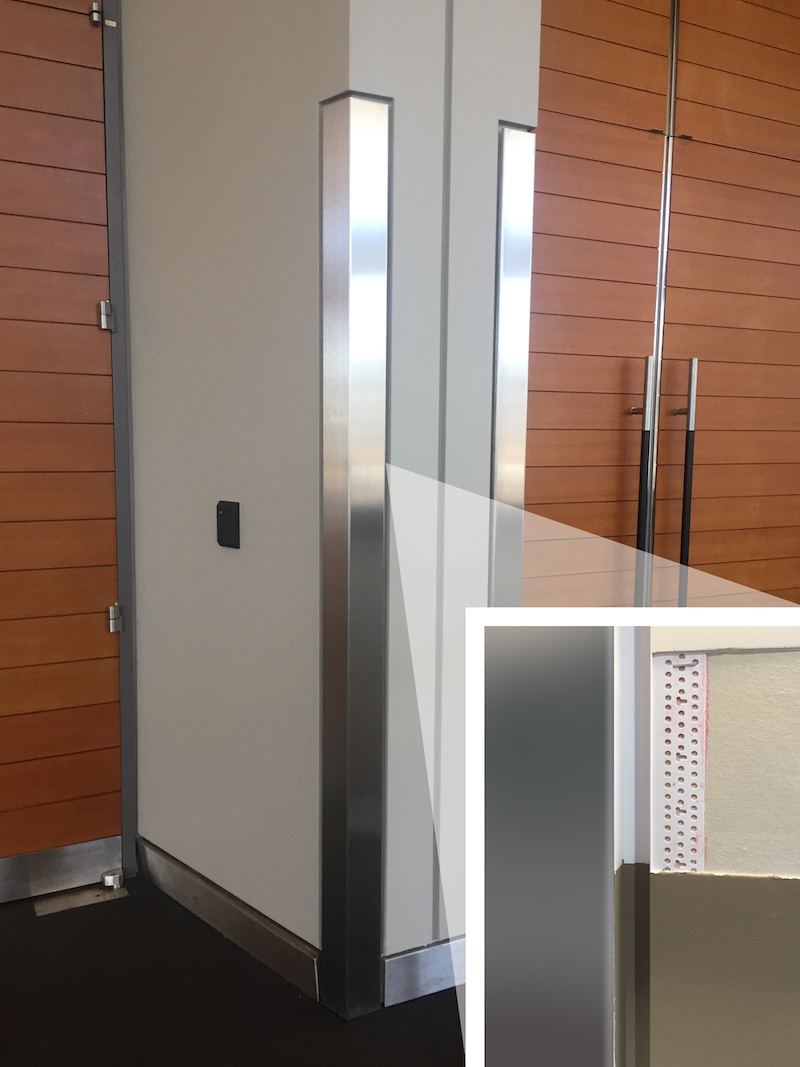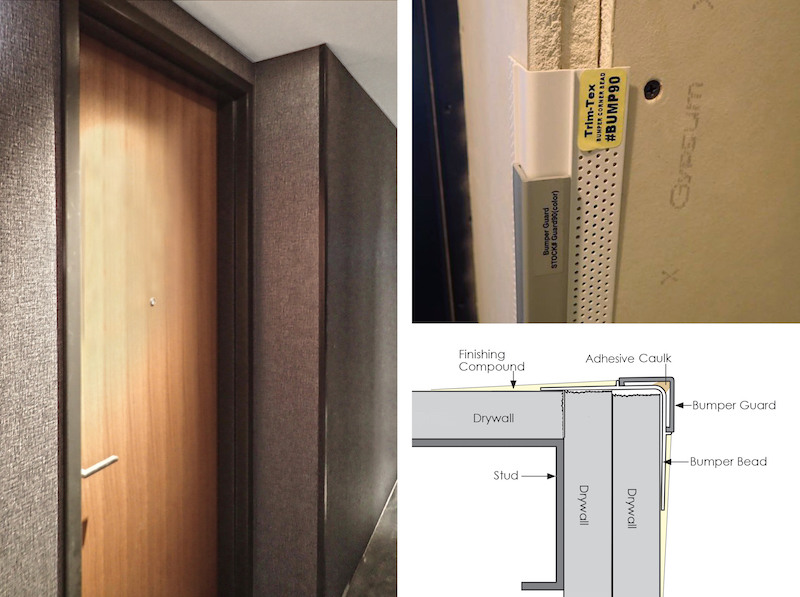When designing a building, architects take great care in defining the space, understanding and optimizing the use of space, and ultimately, creating a design that will be not only eye-catching, but functional. Good design ensures that the space is utilized well and that it will survive for many years to come.
This is why interior finishing is so crucial: good interior finishing adds beauty to the space while also ensuring the construction’s durability. Additionally, investing in good interior finishing will lower long-term cost to the building’s owner and tenants. Interior finishing has a profound effect on a space’s safety and durability.
In this vein, drywall is a popular interior finishing material because of its cost-effectiveness. In addition to being an inexpensive material, it also provides good fire resistance. However, drywall sheets can be fragile, especially at the porous edges. When used in high-traffic spaces (like commercial interiors), or high-energy spaces (like homes with small children), the opportunity for collisions with drywall edges are elevated. Finishing those edges, especially corners, with a durable material makes them resistant to impact and will reduce the cost of repairs during the entire lifetime of the building.
Rigid vinyl finishing is particularly advantageous at providing corner protection. Unlike traditional metal corner protectors, vinyl is flexible enough to spring back to shape after impact– metal can dent permanently, necessitating otherwise avoidable repairs. Vinyl also avoids the corrosion problems inherent with metal corner finishing.
 Right detail shows shadow bead installation process with drywall compound and paint. Location, Boston Convention and Exhibition Center.
Right detail shows shadow bead installation process with drywall compound and paint. Location, Boston Convention and Exhibition Center.
Of course, interior finishing is about style as much as function, and fortunately, corner protection products are available in any number of styles. Within these many finishing styles, “flush” corner protection stands out for its appealing modern sensibility. Corner protectors that fit flush allow for particularly crisp, clean lines that create a strong, minimal style.
Some flush corner beads, like Trim-Tex Bumper Bead, allow the integration of protective vinyl corners and wallpaper in a way that feels intentional, pulling the corner protector into the design rather than leaving it to feel like a protective afterthought. Bumper Bead is available in a wide variety of colors, allowing it to be tastefully integrated with any wallpaper or paint color.
The Marriot Marquis hotel in Chicago, IL. chose Bumper Bead to provide corner protection from carts and luggage rolling through the hallways. Additionally, Bumper Bead’s floor to ceiling protection prevents the visual break that traditional corner guards cause when they stop halfway up the wall.
Another method of creating flush corner protection is with the use of a shadow bead. With a second layer of drywall, cut away the drywall from the corner to fit the width of the shadow bead and corner guard. To finish the drywall edge a shadow bead is installed around the edges of the corner guard. Notice how the metal corner guard sits flush with the wall surface, and is outlined by clean, perfectly straight shadows.
Turn an afterthought into a well-intentioned interior finishing statement with flush corner protection.
Related Stories
| Aug 11, 2010
Great Solutions: Business Management
22. Commercial Properties Repositioned for University USE Tocci Building Companies is finding success in repositioning commercial properties for university use, and it expects the trend to continue. The firm's Capital Cove project in Providence, R.I., for instance, was originally designed by Elkus Manfredi (with design continued by HDS Architects) to be a mixed-use complex with private, market-...
| Aug 11, 2010
Seven tips for specifying and designing with insulated metal wall panels
Insulated metal panels, or IMPs, have been a popular exterior wall cladding choice for more than 30 years. These sandwich panels are composed of liquid insulating foam, such as polyurethane, injected between two aluminum or steel metal face panels to form a solid, monolithic unit. The result is a lightweight, highly insulated (R-14 to R-30, depending on the thickness of the panel) exterior clad...
| Aug 11, 2010
Nurturing the Community
The best seat in the house at the new Seahawks Stadium in Seattle isn't on the 50-yard line. It's in the southeast corner, at the very top of the upper bowl. "From there you have a corner-to-corner view of the field and an inspiring grasp of the surrounding city," says Kelly Kerns, project leader with architect/engineer Ellerbe Becket, Kansas City, Mo.
| Aug 11, 2010
AIA Course: Historic Masonry — Restoration and Renovation
Historic restoration and preservation efforts are accelerating throughout the U.S., thanks in part to available tax credits, awards programs, and green building trends. While these projects entail many different building components and systems, façade restoration—as the public face of these older structures—is a key focus. Earn 1.0 AIA learning unit by taking this free course from Building Design+Construction.
| Aug 11, 2010
AIA Course: Enclosure strategies for better buildings
Sustainability and energy efficiency depend not only on the overall design but also on the building's enclosure system. Whether it's via better air-infiltration control, thermal insulation, and moisture control, or more advanced strategies such as active façades with automated shading and venting or novel enclosure types such as double walls, Building Teams are delivering more efficient, better performing, and healthier building enclosures.
| Aug 11, 2010
Glass Wall Systems Open Up Closed Spaces
Sectioning off large open spaces without making everything feel closed off was the challenge faced by two very different projects—one an upscale food market in Napa Valley, the other a corporate office in Southern California. Movable glass wall systems proved to be the solution in both projects.
| Aug 11, 2010
AIA course: MEP Technologies For Eco-Effective Buildings
Sustainable building trends are gaining steam, even in the current economic downturn. More than five billion square feet of commercial space has either been certified by the U.S. Green Building Council under its Leadership in Energy and Environmental Design program or is registered with LEED. It is projected that the green building market's dollar value could more than double by 2013, to as muc...
| Aug 11, 2010
BIM adoption tops 80% among the nation's largest AEC firms, according to BD+C's Giants 300 survey
The nation's largest architecture, engineering, and construction companies are on the BIM bandwagon in a big way, according to Building Design+Construction's premier Top 50 BIM Adopters ranking, published as part of the 2009 Giants 300 survey. Of the 320 AEC firms that participated in Giants survey, 83% report having at least one BIM seat license in house, half have more than 30 seats, and near...
| Aug 11, 2010
Thrown For a Loop in China
While the Bird's Nest and Water Cube captured all the TV coverage during the Beijing Olympics in August, the Rem Koolhaas-designed CCTV Headquarters in Beijing—known as the “Drunken Towers” or “Big Shorts,” for its unusual shape—is certain to steal the show when it opens next year.
| Aug 11, 2010
Tall ICF Walls: 9 Building Tips from the Experts
Insulating concrete forms have a long history of success in low-rise buildings, but now Building Teams are specifying ICFs for mid- and high-rise structures—more than 100 feet. ICF walls can be used for tall unsupported walls (for, say, movie theaters and big-box stores) and for multistory, load-bearing walls (for hotels, multifamily residential buildings, and student residence halls).








